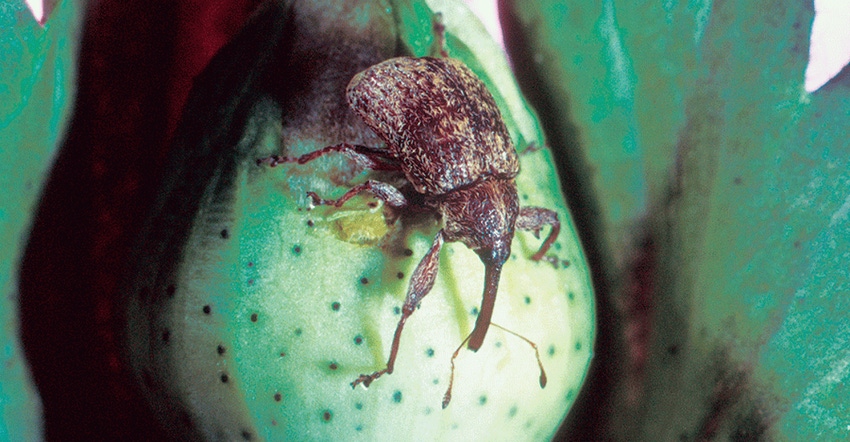
How they got there is uncertain, but two Mexican boll weevils were recently trapped near Batesville, Miss., in Panola County.
No reason to panic, say Extension and Boll Weevil Eradication sources from Mississippi and surrounding states, but BWEP personnel plan closer scrutiny and increased trapping frequency until frost.
Immediately following the discovery, Boll Weevil Eradication Program personnel ramped up trapping schedules for the area near the spot where the two weevils were caught.
As of Monday, Oct. 8, scouts had found no more weevils, but BWEP planned enhanced trapping for at least another week.
Where they came from remains a mystery. Initial assumptions cited the possibility that they came in on harvest equipment from Texas, but no definitive evidence supports that theory.
Two harvesters that came in from Texas did not come from an infested area and were unloaded 7 miles or more on the west side of Batesville, according to reports from Boll Weevil Eradication personnel.
The two boll weevils were taken to Richard Brown, director, Mississippi Entomological Museum, Mississippi State University, for official identification. “Ryan Whitehouse, a research associate on staff here at the museum performed the dissection and identification,” says Brown. �“Whitehouse is the country’s leading authority on boll weevils and determined the two Mexican boll weevils were male.”
In the last 10 years, only four boll weevils have been forwarded to Brown and Whitehouse for identification. “The morphology of the Mexican boll weevil is slightly different from the southeastern boll weevil, but they can deliver the same damage to cotton,” explains Whitehouse. “Boll weevils can overwinter in ground trash along the periphery of a field and hitch a ride on equipment, logs, or may even be blown across state lines.”
Scouts continue to check traps around the perimeter of fields near where the weevils were caught.
The program is following a designated protocol set up by the National Cotton Council’s Boll Weevil Action Committee established for all states. That protocol dictates further actions if other weevils are detected.
Arkansas on Alert
Arkansas also tightened trapping procedures following Mississippi’s weevil discovery.
Arkansas Extension agent Robert Goodson says DNA samples indicated that the two weevils trapped in Mississippi were, “Mexican boll weevils from (the Southwest) area and not Southeast weevils, which are the ones we had in Arkansas and the Mid-South. So, that is good news.”
He adds that the threat to the cotton industry remains a concern. “We must take precautions to prevent re-infestation. Regina Coleman, director of the Arkansas Boll Weevil Eradication Program (ABWEP), is being proactive to assure that Arkansas is fully protected from any threat to the cotton industry in our state,” he says in a recent memo.
Godson adds: “The technical advisory committee, consisting of University of Arkansas entomologists, USDA and the Arkansas State Plant Board, and I met last Wednesday. Based on that meeting, the ABWEP has increased trapping at the bridges at West Memphis, Helena, and Lake Village and increased trapping along the Mississippi River to make sure no weevils sneak into Arkansas.
“Also, trapping has been increased at Texarkana. The frequency of trap running until frost will increase to twice per week to ensure that if weevils are caught we can react as quickly as possible.”
Goodson says regulations remain intact on the Pink Bollworm Eradication Program, “which assures stalk destruction and inspection of all cotton equipment, including pickers, module builders, etc., from other states, and certificates certifying sanitation of equipment. Also, we asked for a hard line on restriction of ornamental/non-commercial cotton.”
Goodson says scouts should send suspect weevils to state identifiers within 24 hours. Those identifiers are: Gus Lorenz, Glenn Studebaker, and Regina Coleman. “Time is critical on identification,” he adds. “If we believe the specimen is a boll weevil, it is rushed to the national identifier immediately.”
Other steps include:
• Be vigilant! Check fields in your area that are still green and look for weevils or signs of weevils in the field.
• If you find a weevil or think you see some feeding, contact us immediately!
• Be aware of and just know that everything we can do to prevent re-entry of this pest into our state is being done.
• Be on the lookout for boll weevils and contact ABWEP and us if you see anything suspicious.
“Millions of dollars were spent to eradicate this pest from our state,” Goodson says. “We need to do everything we can to protect that investment. We can do that by being vigilant around cotton growing areas. Please call if you have any questions.”
Adjacent States
Louisiana has seen no boll weevils. “We have not changed anything as of now,” says Dan Fromme, associate professor, LSU Agriculture Center, Alexandria. “We are closely watching Mississippi,” he says.
“Other than some text chatter with my counterparts, I’ve not heard many details,” says Scott Stewart, University of Tennessee Institute of Agriculture professor and IPM coordinator.
“I’m expecting some information from our local folks soon,” he adds.
Stewart says the late-season catch diminishes the significance, to some degree. “As late as it is, and considering the catches in Mississippi are just a few (and close but not too close to Tennessee), I don’t expect substantial changes (in trapping procedures) this year. We might see some increased trapping efforts along the state line next spring, but that is purely speculation and dependent upon the scope of the situation in Mississippi.”
He says trapping decisions will be made by the Tennessee Boll Weevil Eradication Foundation, “for which I provide technical guidance, although minimal now, given the long history of the program.”
Movement of equipment across state lines and from quarantined zones is restricted. Here are the regulations for Mississippi.
Regulated Articles 104 The following articles shall be regulated by this Rule: 1. The boll weevil, Anthonomus grandis Boheman, in any living stage of development. 2. Gin trash. 3. Seed cotton 4. Cotton plants, bolls. 5. Used cotton equipment. 6. Any other products, articles, means of conveyance, or any other item whatsoever which is determined by the Commissioner to present a hazard in the spread of the boll weevil and the person in possession of such item has been so notified. (Adopted November 12, 1993.) Source: Miss. Code Ann. §69-37-3 (Rev. 2010). Conditions Governing Movement of Regulated Articles 105.01 Certificate or Permit Required 1. Except as described below in 105.02 (3), regulated articles moving from a regulated area/quarantined zone into, through or within the State of Mississippi shall be accompanied by a certificate or permit issued by an authorized regulatory official of the State where such articles originated. 2. Regulated articles originating outside a regulated area may be moved into, through or within Mississippi, without a certificate or permit, if accompanied by documentation of the point of origin, and if, to the satisfaction of the Commissioner, such articles have been adequately protected from boll weevil infestation during movement through all regulated areas. (Adopted November 12, 1993.) 105.02 Issuance of Certificates and Permits 1. Certificates for movement of regulated articles may be issued by the commissioner when such articles: a. Originated in non-infested non-quarantined area in the State of Mississippi and have not been otherwise exposed to infestation….
About the Author(s)
You May Also Like






